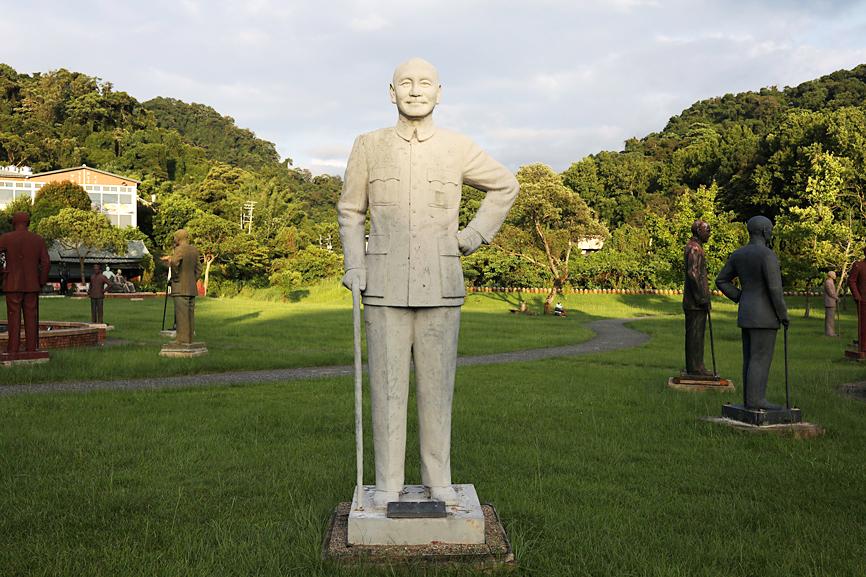As of this month, 54 organizations have completed plans to remove, or have already removed, icons of authoritarian rule from public spaces in compliance with the Transitional Justice Commission’s regulations.
The Central Police University and the Taiwan Police College have agreed to rename their Zhongzheng halls, while the college also plans to remove two statues of former president Chiang Kai-shek (蔣介石).
The Executive Yuan’s Central Taiwan Joint Services Center moved a statue of Chiang to Taoyuan’s Cihu Memorial Sculpture Park, while a statue at Taian Service Area in Taichung, the largest statue at a rest station on a national freeway, is to be removed next year, the source said.

Photo: Ann Wang, Reuters
The statue of Chiang at Chiayi County’s Jhaoping Station has been removed, while three statues at the Ministry of Justice offices in New Taipei City, Taoyuan and Changhua County have been removed, the commission said.
The Zhongzheng Building under the Ministry of Civil Service’s Muzha Office in Taipei’s Wenshan District (文山) would be renamed and its plaque would be removed this summer, the commission added.
Fourteen statues of Chiang Kai-shek and two portraits of former president Chiang Ching-kuo (蔣經國) at companies affiliated with the Ministry of Economic Affairs have been removed, while a half-bust of Chiang Kai-shek has been repurposed as a windmill, the commission said.
A statue of Chiang Kai-shek at the Chiayi County Tourism Bureau has been blocked from sight with a display panel, while the statue of him at Taitung County Airport was removed last year, the commission said.
Five of his statues at Coast Guard Administration bases — three at Kaohsiung bases, and one each in Taoyuan and Taitung — were removed, while the name Zhongzheng was struck from platforms at the bases, the commission said.
The Fishery Agency has put into storage a Chiang Ching-kuo relief originally featured in its Keelung office, the commission said.
Three statues of Chiang Kai-shek at homes for elderly people under the Ministry of Health and Welfare were removed, the commission said.
The commission did not arbitrarily state how the statues should be handled, and most of the methods were proposed by the respective agencies, Commissioner Deputy Director Yeh Hung-ling (葉虹靈) said.
Except for the Ministry of National Defense, the Veterans Affairs Council and the Ministry of Education, there are still 38 places where “icons of authoritarian rule” remain unprocessed, Yeh said.
The commission would continue to work with governmental agencies and convey to them what transitional justice symbolizes and how they could implement it, Yeh said.

US climber Alex Honnold is to attempt to scale Taipei 101 without a rope and harness in a live Netflix special on Jan. 24, the streaming platform announced on Wednesday. Accounting for the time difference, the two-hour broadcast of Honnold’s climb, called Skyscraper Live, is to air on Jan. 23 in the US, Netflix said in a statement. Honnold, 40, was the first person ever to free solo climb the 900m El Capitan rock formation in Yosemite National Park — a feat that was recorded and later made into the 2018 documentary film Free Solo. Netflix previewed Skyscraper Live in October, after videos

Starting on Jan. 1, YouBike riders must have insurance to use the service, and a six-month trial of NT$5 coupons under certain conditions would be implemented to balance bike shortages, a joint statement from transportation departments across Taipei, New Taipei City and Taoyuan announced yesterday. The rental bike system operator said that coupons would be offered to riders to rent bikes from full stations, for riders who take out an electric-assisted bike from a full station, and for riders who return a bike to an empty station. All riders with YouBike accounts are automatically eligible for the program, and each membership account

NUMBERS IMBALANCE: More than 4 million Taiwanese have visited China this year, while only about half a million Chinese have visited here Beijing has yet to respond to Taiwan’s requests for negotiation over matters related to the recovery of cross-strait tourism, the Tourism Administration said yesterday. Taiwan’s tourism authority issued the statement after Chinese-language daily the China Times reported yesterday that the government’s policy of banning group tours to China does not stop Taiwanese from visiting the country. As of October, more than 4.2 million had traveled to China this year, exceeding last year. Beijing estimated the number of Taiwanese tourists in China could reach 4.5 million this year. By contrast, only 500,000 Chinese tourists are expected in Taiwan, the report said. The report

Temperatures are forecast to drop steadily as a continental cold air mass moves across Taiwan, with some areas also likely to see heavy rainfall, the Central Weather Administration (CWA) said. From today through early tomorrow, a cold air mass would keep temperatures low across central and northern Taiwan, and the eastern half of Taiwan proper, with isolated brief showers forecast along Keelung’s north coast, Taipei and New Taipei City’s mountainous areas and eastern Taiwan, it said. Lows of 11°C to 15°C are forecast in central and northern Taiwan, Yilan County, and the outlying Kinmen and Lienchiang (Matsu) counties, and 14°C to 17°C